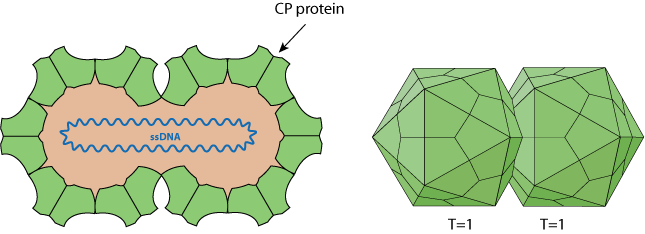VIRION

Non-enveloped, about 38 nm in length and 22 nm in diameter (for MSV), twinned (geminate) incomplete T=1 icosahedral symmetry capsid that contains 22 pentameric capsomers made of 110 capsid proteins (CP). Each geminate particle contains only a single circular ssDNA.
GENOME
Mono-, or bipartite, circular, ssDNA genome (+) of about 2.5-3.0 (monopartite) or 4.8-5.6 kb (bipartite). The number of genome segments depends on the genera. 3' terminus has no poly(A) tract. There are coding regions in both the virion (positive) and complementary (negative) sense strands.
The genome is replicated through double-stranded intermediates. The replication (Rep) protein initiates and terminates rolling circle replication, the host DNA polymerase being used for DNA replication itself. There is a potential stem-loop structure in the intergenic region that includes a conserved nona-nucleotide sequence (TAATATTAC) where ssDNA synthesis is initiated.
GENE EXPRESSION
Transcription is bidirectional (c-sense and v-sense). Most of the time, proteins encoded on the c-sense are involved in DNA replication, in regulation of transcription and in interfering with cellular processes, whereas proteins encoded on the v-sense have movement and structural functions.
ENZYMES
REPLICATION
NUCLEAR
- Virus penetrates into the host cell.
- Uncoating, the viral ssDNA genome penetrates into the nucleus.
- The ssDNA is converted into dsDNA with the participation of cellular factors.
- bidirectional dsDNA transcription from the IR promoter produces viral mRNAs and translation of viral proteins.
- Replication is initiated by cleavage of the(+)strand by REP, and occurs by rolling circle producing ssDNA genomes.
- These newly synthesized ssDNA can either
a) be converted to dsDNA and serve as a template for transcription/replication
b) be encapsidated by capsid protein and form virions released by cell lysis.
c) be transported outside the nucleus, to a neighboring cell through plasmodesmata (cell-cell movement) with the help of viral movement proteins.


